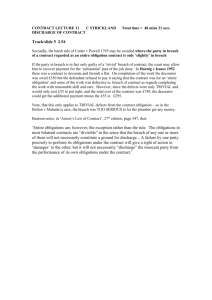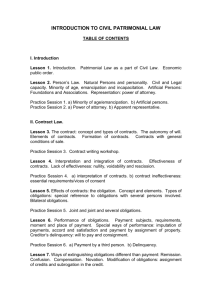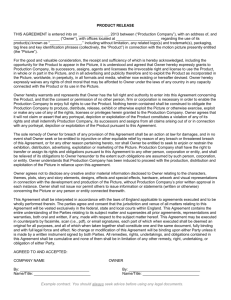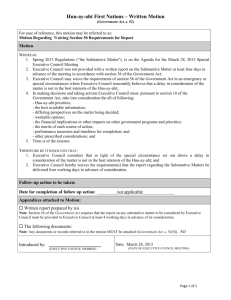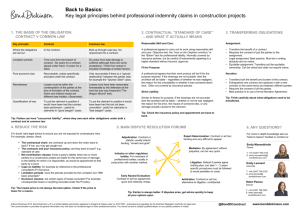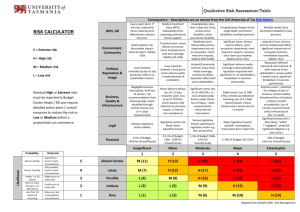lawoffinancefullsynopsis
advertisement
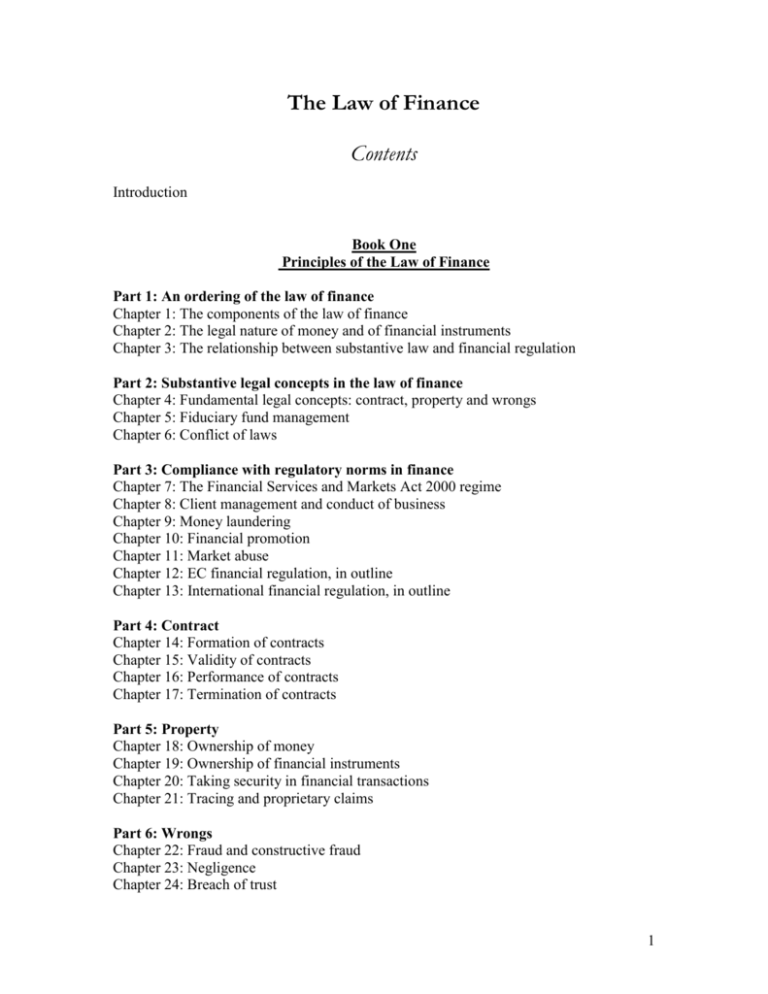
The Law of Finance Contents Introduction Book One Principles of the Law of Finance Part 1: An ordering of the law of finance Chapter 1: The components of the law of finance Chapter 2: The legal nature of money and of financial instruments Chapter 3: The relationship between substantive law and financial regulation Part 2: Substantive legal concepts in the law of finance Chapter 4: Fundamental legal concepts: contract, property and wrongs Chapter 5: Fiduciary fund management Chapter 6: Conflict of laws Part 3: Compliance with regulatory norms in finance Chapter 7: The Financial Services and Markets Act 2000 regime Chapter 8: Client management and conduct of business Chapter 9: Money laundering Chapter 10: Financial promotion Chapter 11: Market abuse Chapter 12: EC financial regulation, in outline Chapter 13: International financial regulation, in outline Part 4: Contract Chapter 14: Formation of contracts Chapter 15: Validity of contracts Chapter 16: Performance of contracts Chapter 17: Termination of contracts Part 5: Property Chapter 18: Ownership of money Chapter 19: Ownership of financial instruments Chapter 20: Taking security in financial transactions Chapter 21: Tracing and proprietary claims Part 6: Wrongs Chapter 22: Fraud and constructive fraud Chapter 23: Negligence Chapter 24: Breach of trust 1 Book Two Modern Financial Techniques in Legal Context Part 7: Domestic Banking Chapter 25: Banker and customer relationship Chapter 26: Negotiable instruments, cash and bills of exchange Chapter 27: Payment methods Chapter 28: Corporate, cross-border banking Part 8: Lending Chapter 29: Ordinary lending Chapter 30: Syndicated lending Chapter 31: Bonds Chapter 32: Foreign exchange transactions Part 9: Stakeholding Chapter 33: Rights of shareholders in ordinary companies Chapter 34: Issues of shares Chapter 35: Official listing of securities Part 10: Refinancing Chapter 36: Financial derivatives Chapter 37: Asset securitisation Part 11: Proprietary finance Chapter 38: Mortgages Chapter 39: Asset leasing Chapter 40: Stock-lending and “repo” transactions Chapter 41: Collateralisation Part 12: Collective investment entities Chapter 42: The use of trusts, partnership and companies in investment Chapter 43: Collective investment schemes Chapter 44: Friendly societies Chapter 45: Co-operatives and credit unions Chapter 46: Occupational pension funds 2 Synopsis Preface Introduction Book One Principles of the Law of Finance PART 1: AN ORDERING OF THE LAW OF FINANCE Part 1 aims to set out what is meant by “the law of finance” and the manner in which the rest of the book is structured. This includes an analysis of the synthesis between substantive law and regulatory norms, such that the latter informs the development of the former. Chapter 1: The components of the law of finance The ambit of finance The definition of “finance” Finance as the wherewithal to act From domestic banking to cross-border transactions Constructing a law of finance Contract, property and tort A synthesis of law and regulation The scope of substantive statute and case law Domestic and international legal norms Law supplemented by market practice The six categories of finance The usefulness of the division Banking Lending Stakeholding Refinancing Proprietary finance Collective investment Themes in the international law of finance Risk Power Globalisation Dematerialisation Privatisation of dispute resolution [15 pages] 3 Chapter 2: The legal nature of money and of financial instruments The nature of money Cash Money in bank accounts The particular context of electronic bank accounts Telegraphic bank transfers across borders Money as a means of establishing value Market value The foreign exchange context Intrinsic value Financial instruments What is a financial instrument Financial instruments as property [10 pages] Chapter 3: The relationship between substantive law and financial regulation The distinction between law and regulation How regulatory norms may inform legal norms The actions of the reasonable banker What bankers can be deemed to know Bankers’ liability for clients’ wrongdoing The importance of this synthesis in the development of the law of finance [10 pages] PART 2: SUBSTANTIVE LEGAL CONCEPTS IN THE LAW OF FINANCE Part 2 sets out the fundamental concepts on which the law of finance will be built: in effect a marriage between contract, property and tort (and other wrongs). Of particular significance is the discussion of “fiduciary fund management” which will cover the liabilities fund managers generally, portfolio investment strategies, and other activities by intermediaries. The law relating to fiduciaries – including the general law on trustees’ and agents’ obligations – is particularly significant in this context. Finally, the core principles of private international law, as they relate to global financial markets, are set out. All of these discussions are intended to facilitate the teaching of finance law by setting out core principles at the outset; they are intended to assist practitioners by collecting core principles in one place and so to facilitate ease of reference. This beginning is then continued in Parts 4 through 6. Chapter 4: Fundamental legal concepts: contract, property and wrongs That English law is built on fundamental concepts applied in particular contexts The law of contract The law of property The law of tort and of wrongs more generally [10 pages] Chapter 5: Fiduciary fund management Definition of a “fiduciary” The context of portfolio fund management 4 Circumstances in which financial institutions may be fiduciaries The obligations of fiduciary officers in general terms Rule against unauthorised profits Constructive trust of secret profits Bribes Authorisation Confidential information Corporate opportunity doctrine Self-dealing principle Conflicts of interest of market makers The obligations of trustees The irreducible core content of trusteeship The investment obligations of trustees under the Trustee Act 2000 The general power of investment The statutory duty of care Standard investment criteria The obligation to take professional advice Express trust provisions Delegation of trustees’ responsibilities The limitation of trustees’ liabilities The obligations of agents The nature of agency The liability of the principal for the acts of the agent Actual and ostensible authority The limitation of agents’ liabilities Themes in fiduciary fund management [30 pages] Chapter 6: Conflict of laws The significance of private international law in global financial markets Choice of law Proper law of a contract Actions in relation to movable property Jurisdiction [20 pages] PART 3: COMPLIANCE WITH REGULATORY NORMS IN FINANCE Part 3 considers the principal regulatory norms established by the Financial Services and Markets Act 2000 and the FSA Rulebooks which govern financial activity in the UK in general. This book does not propose to deal with regulation in detail – instead it is a book which focuses primarily on substantive law – but it will outline the key concepts in this Part 3. There is also a contextual discussion of EC and International initiatives to regulate financial activity as it informs the practice of that activity. 5 Chapter 7: The Financial Services and Markets Act 2000 regime The economic objectives of the FSMA 2000 The establishment of the Financial Services Authority The general duties of the FSA The powers of the FSA Regulated activities under FSMA 2000 [10 pages] Chapter 8: Client management FSA Conduct of Business Rules The need to allocate clients into appropriate categories Suitability Suitability of the treatment of a client Suitability of the product for the client Client money [15 pages] Chapter 9: Money laundering The context of money laundering regulation “Know your client” regulation Recovery of laundered money under substantive law [15 pages] Chapter 10: Financial promotion The context of marketing investment products The FSMA Financial Promotion regime Liability for unlawful financial promotion [10 pages] Chapter 11: Market abuse and insider dealing The FSMA Market Abuse regime The FSMA Tribunal Insider dealing [10 pages] Chapter 12: EC regulation The principles underpinning EC regulation Banking Co-ordination Directives Investment Services Directives Solvency Ratio Directives Capital Adequacy Directives [10 pages] Chapter 13: International regulation The context of international financial regulation Basle 6 BIS IOSCO Specific market regulation [10 pages] PART 4: CONTRACT Part 4 marries the discussion in Parts 2 and 3 and then considers them in terms of the substantive law of contract. Most of the substantive law relating to financial transactions is concerned with the law of contract in some way. The discussion is organised in such a way that legal principles are identified as relating to specific problems in the practice of the law of finance: this will enable discussions of specific financial products in Book Two to refer back to these principles and so keep those later discussions concise. Chapter 14: Formation of contracts The contractual negotiation process Between market counterparties Between professional and retail client Offer and acceptance Consideration Hierarchies of express contractual terms Implied terms Good faith in the creation of contracts Time and place of the creation of a contract Standard form contractual terms [40 pages] Chapter 15: Validity of contracts Invalidating factors at general law Mistake Misrepresentation Fraud Illegality Gaming contracts Insurance contracts Capacity and powers of the parties Individuals Companies Partnerships Trusts Contracts conducted through agents Unfair contract terms Unconscionable bargains [35 pages] 7 Chapter 16: Performance of contracts Proper performance of contractual obligations Frustration of contract Specific performance of contracts Remedies for breach of contract Payment netting [25 pages] Chapter 17: Termination of contracts Express contractual provisions effecting termination Recovery of payments made Actions for money had and received Actions for damages Actions for compensation Rescission Recovery of property Actions to assert title Tracing claims (cf. Ch. 21) Recovery of loss in general terms [35 pages] PART 5: PROPERTY As with Part4, only Part 5 considers specifically the manner in which the substance of financial transactions will constitute property in themselves and, particularly significantly, how participants in financial transactions take security. This latter topic is of particular importance in practice and remains a key feature of many postgraduate courses. Chapter 18: Ownership of money The legal nature of money The particular problem of taking proprietary rights in electronic money Certainty of subject matter Loss of the right to trace Calculating loss in relation to currency [10 pages] Chapter 19: Ownership of financial instruments Financial instruments as choses in action Complex financial instruments as bundles of choses in action Taking title in choses in action Taking title in the benefits to flow from a financial instrument [10 pages] Chapter 20: Taking security and insolvency in financial transactions The fundamental techniques of taking security in financial transactions 8 Retention of title Fixed charge Floating charge Charges over book debts Express trust Quistclose trust Pledge Collateralisation and pre-payment (cf. Ch 41) Guarantee The nature of insolvency English law (in outline) Set-off on insolvency [40 pages] Chapter 21: Tracing and proprietary claims Actions to recover property or to claim substitute property Specific restitution Tracing at common law Tracing in equity Equitable claims and remedies Constructive trust Lien Equitable charge Subrogation [30 pages] PART 6: WRONGS As with Part 4, only in relation to tort and to other wrongs (such as breach of trust and equitable fraud). Chapter 22: Fraud and constructive fraud Deceit Fraudulent misrepresentation Undue influence Duress [25 pages] Chapter 23: Negligence Negligent misstatement Mispredictions Liability of financial intermediaries [25 pages] Chapter 24: Breach of trust Breach of fiduciary duty Liability of trustee for breach of trust 9 Breach of trust as a fund manager Breach of fiduciary duty generally Personal liability to account for participation in a breach of trust The two heads of liability Extent of the liability to account Requirement of a breach of trust Dishonest assistance in a breach of fiduciary duty Assistance Dishonesty Knowing receipt of property in breach of fiduciary duty Receipt Knowledge Liability for breach of trust generally in the corporate context Liability of a financial institution for the actions of an employee Liability of employee for actions of another Tracing (cf Ch. 21) [30 pages] [Maximum 480 pages in total in this Book One] Book Two Modern Financial Techniques in Legal Context PART 7: BANKING Part 7 is concerned with what might be termed traditional English banking law, together with a consideration of the particular issues which arise in relation to cross-border banking. The discussion divides between the relationship between banker and customer (including the maintenance of accounts), then the nature of assets used by banks, then the various methods by which payments are made in banking transactions, and finally cross-border banking. Chapter 25: Banker and customer relationship The nature of the contract between banker and customer The debtor-creditor relationship Implied terms Exclusion clauses The banker’s duty of confidence The banker as a trustee Bank accounts Current accounts Deposit accounts Issues relating to joint accounts Overdrafts and loan accounts Banker’s rights relating to the treatment of moneys The banker’s lien 10 Rights of appropriation Combination of accounts [40 pages] Chapter 26: Negotiable instruments, cash and bills of exchange Negotiable instruments Cash Bills of exchange [15 pages] Chapter 27: Payment methods Payment methods Cheques Debit cards Credit cards Electronic payment systems [30 pages] Chapter 28: Corporate cross-border banking Letters of credit Regulation of banks acting across borders Protection of customers Access to assets in different jurisdictions Injunctions in the international context [25 pages] PART 8: LENDING Part 10 considers a range of transactions concerned with lending of money, whether under an ordinary contract of loan or by means of the issue of a security in relation to that loan. Lending in this context relates to ordinary bank lending as well as to syndicated lending from a number of lenders. Foreign exchange transactions considers the particular context of lending money in different currencies from sterling. Chapter 29: Ordinary lending The contract of loan Loan covenants [15 pages] Chapter 30: Syndicated lending The nature of syndicated lending Documentation issues [15 pages] 11 Chapter 31: Bonds The commercial nature of bond and Eurobond issues Eurobonds admitted to the Official List Official listing of securities (cf Ch 35) The role of the Eurobond trustee Covenants in Eurobond issues The nature of debentures [20 pages] Chapter 32: Foreign exchange transactions Issues relating to loans in foreign exchange markets Cross-currency borrowing Cross-currency swaps [15 pages] PART 9: STAKEHOLDING Part 11 is concerned with the situation in which an individual acquires an ownership stake in the asset acquired – the specific example considered here being the ownership of shares in an ordinary company. Chapter 33: Rights of shareholders in ordinary companies The legal personality of a company The purposes of shareholders in ordinary companies Institutional fund managers Return on capital by way of dividend Speculative return on sale of the capital asset Shell and holding companies The rights of shareholders in ordinary companies The right to participate on a winding-up The right to receive a dividend The competence of directors in relation to the conduct of the company’s affairs The vires of the company The rights of minority shareholders and the rule in Foss v Harbottle [20 pages] Chapter 34: Issues of shares The manner in which shares are issued Types of share issue Marketing securities Promoters Civil liability for the preparation of a prospectus The golden rule in relation to prospectuses Rescission in relation to issues of shares Compensation under s 90, FSMA 2000 Criminal liability for the preparation of a prospectus 12 Offers of unlisted shares Offers of listed shares (cf. Ch 35) Allotment of shares [20 pages] Chapter 35: Official listing of securities The offer of securities to the public EC Directives on the listing of securities Listing Rules and the role of the Competent Authority Admission to listing The application procedure Sponsors and listing agents Refusal of listing Admission to the Official List Listing particulars The requirement for a prospectus or listing particulars Publication of the prospectus The contents of a prospectus The obligation of disclosure Authorisation to omit information Persons responsible for the prospectus Obligations imposed on the issuer by the Listing Rules The Model Code Discontinuance and suspension of listing [30 pages] PART 10: REFINANCING Part 12 is dubbed “refinancing”, as will be explained in Ch 1, on the basis that it enables the contracting parties to alter some existing financing obligation. So, for example, interest rate swaps (in the financial derivatives discussion) permit the recalibration of obligations to pay interest, and asset securitisation enables the borrower to use income receivables to generate a capital gain. Chapter 36: Financial derivatives The basic techniques of derivatives Forwards Options Swaps Innovation based on these techniques The commercial purposes of derivatives The documentation architecture Confirmations Master Agreements Events of default and termination events Taking security (cross-reference to Ch. 41) Liability of sellers of complex derivatives products 13 Case study: the local authority swaps cases [40 pages] Chapter 37: Asset securitisation The structure of a securitisation transaction Loan to acquire receivables Credit Saleability True sale Further legal limitations on securitisations Documentation Funding loan documentation Transfer agreement Administration agreement Credit enhancement structure Security trust deed Specific legal issues Assignability of the receivables Characterisation of the security for the transaction The solvency of the seller [30 pages] PART 11: PROPRIETARY FINANCE Part 13 considers a range of financial transactions which are loosely organised around the acquisition of identified items of property, where the “finance” refers to the wherewithal to acquire that asset by means of mortgage or asset financing; or alternatively to the use of assets to provide speculative or other return, as with stock-lending or repo transactions; or the use of assets to provide security for some underlying transactions, as with collateralisation or margin credit. Chapter 38: Mortgages The nature of a mortgage Mortgages of land under the Law of Property Act 1925 Mortgages of chattels (cf. Ch 39) Equitable mortgage The equity of redemption Mortgagee’s remedies Possession Sale Undue influence Misrepresentation Actual undue influence Presumed undue influence Vitiated consent or unconscionability Setting aside the mortgage Unconscionable transactions 14 [35 pages] Chapter 39: Asset leasing The nature of asset leasing The similarity to mortgages and problems with re-characterisation Retention of title Sale and leaseback Structure of sale and leaseback transaction (cf Ch 40) Documentation Finance leasing Regulation Warranties by manufacturer of asset Leveraged leases Guarantees Sub-leasing Documentation Hire purchase (in outline) [15 pages] Chapter 40: Stock-lending and “repo” transactions The nature and purpose of stock-lending transactions The possible structures of stock-lending or “repo” transactions Outright transfer with right to receive property of like kind Obligation to maintain specific asset transferred Outright transfer with credit enhancement or collateralisation Documentation [15 pages] Chapter 41: Collateralisation The structure of collateralisation agreements Trust Pledge Registrable charge Issues with the use of securities as collateral The nature of securities issued under a global note Settlement of securities Delivery of securities Certainty of subject matter The netting and risk management benefits of collateralisation structures The efficacy of collateral agreements as security arrangements [10 pages] 15 PART 12: COLLECTIVE INVESTMENT ENTITIES Part 14 is concerned with the entities used by ordinary retail clients when seeking to invest their own money. In essence, it cherry-picks these areas from my The Law on Investment Entities (Sweet & Maxwell, 2000). The theory is that all investment entities are built on combinations of property rules (especially trusts) and contract rules (e.g. partnerships) to construct means of holding investment capital in common. This has led to ordinary companies, unit trusts, friendly societies and co-operatives in English law. Chapter 42: The use of trusts, partnership and companies in investment The nature of “investment”, as opposed to the conduct of a business The use of contract and property to achieve investment goals The distinction between investment, property management and a business The development of companies from trust and partnership The rights and liabilities associated with trusts The rights and liabilities associated with partnerships The rights and liabilities associated with companies [15 pages] Chapter 43: Collective investment schemes The definition of “collective investment schemes” The UCITS Directive The FSMA 2000 Unit trusts The commercial structure of the unit trust The unit trust as a trust The obligations of the scheme manager The obligations of the trustee The rights of participants Open-ended investment companies The commercial structure of the open-ended investment company The obligations of the Authorised Corporate Director The obligations of the depositary The rights of participants Overseas schemes [30 pages] Chapter 44: Friendly societies The historical development of friendly societies Unincorporated associations in general terms Founded on contract, not trust The ownership of scheme property Winding up unincorporated associations The commercial development of friendly societies Unincorporated friendly societies The definition of a “friendly society” 16 The relationship between the members and the society The management of friendly societies Winding up Incorporated friendly societies after 1992 The process and effect of incorporation Conversion of existing friendly societies The purposes and powers of a friendly society Winding up a friendly society Registration as a friendly society Regulation of friendly societies by FSA The ambit of FSA regulation The maintenance of prudent management The conduct of investment business The conduct of insurance business [15 pages] Chapter 45: Co-operatives and credit unions Industrial and provident societies IPS as co-operatives The requirement of activities for the benefit of the community The rights of members The duties of officers Credit unions The nature of a credit union The common bond The rights of members The duties of officers Control of assets by members without ownership of any thing The future for co-operatives and credit unions [15 pages] Chapter 46: Occupational pension funds The nature of an occupational pension fund scheme The relationship between the parties The rights of the beneficiaries Beneficiaries are not volunteers The relationship of the employer to the beneficiaries The relationship of the employer to the trustees The obligations of the trustees The obligations to perform the trust The duty to act in the best interests of the beneficiaries The duty to act with reasonable care Duties in relation to the management of the scheme The duty to invest The Minimum Funding Requirement Equal treatment 17 Title to surpluses Penalties for mismanagement The role of OPRA Powers of amendment Termination of an occupational pension scheme [30 pages] [Maximum 480 pages total for this Book Two] 18
